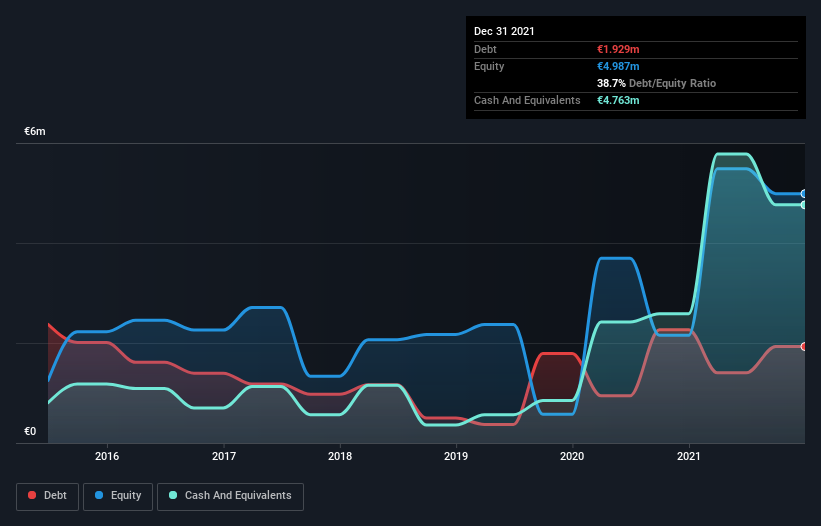
Howard Marks put it nicely when he said that, rather than worrying about share price volatility, 'The possibility of permanent loss is the risk I worry about... and every practical investor I know worries about.' So it seems the smart money knows that debt - which is usually involved in bankruptcies - is a very important factor, when you assess how risky a company is. Importantly, Intrasense SA (EPA:ALINS) does carry debt. But should shareholders be worried about its use of debt?
When Is Debt Dangerous?
Generally speaking, debt only becomes a real problem when a company can't easily pay it off, either by raising capital or with its own cash flow. In the worst case scenario, a company can go bankrupt if it cannot pay its creditors. While that is not too common, we often do see indebted companies permanently diluting shareholders because lenders force them to raise capital at a distressed price. Of course, debt can be an important tool in businesses, particularly capital heavy businesses. The first thing to do when considering how much debt a business uses is to look at its cash and debt together.
View our latest analysis for Intrasense
What Is Intrasense's Net Debt?
As you can see below, Intrasense had €1.93m of debt at December 2021, down from €2.26m a year prior. But it also has €4.76m in cash to offset that, meaning it has €2.83m net cash.

How Strong Is Intrasense's Balance Sheet?
Zooming in on the latest balance sheet data, we can see that Intrasense had liabilities of €2.08m due within 12 months and liabilities of €1.70m due beyond that. On the other hand, it had cash of €4.76m and €1.74m worth of receivables due within a year. So it actually has €2.72m more liquid assets than total liabilities.
It's good to see that Intrasense has plenty of liquidity on its balance sheet, suggesting conservative management of liabilities. Given it has easily adequate short term liquidity, we don't think it will have any issues with its lenders. Succinctly put, Intrasense boasts net cash, so it's fair to say it does not have a heavy debt load! The balance sheet is clearly the area to focus on when you are analysing debt. But you can't view debt in total isolation; since Intrasense will need earnings to service that debt. So when considering debt, it's definitely worth looking at the earnings trend. Click here for an interactive snapshot.
In the last year Intrasense wasn't profitable at an EBIT level, but managed to grow its revenue by 22%, to €4.2m. With any luck the company will be able to grow its way to profitability.
So How Risky Is Intrasense?
We have no doubt that loss making companies are, in general, riskier than profitable ones. And we do note that Intrasense had an earnings before interest and tax (EBIT) loss, over the last year. And over the same period it saw negative free cash outflow of €1.4m and booked a €1.2m accounting loss. With only €2.83m on the balance sheet, it would appear that its going to need to raise capital again soon. With very solid revenue growth in the last year, Intrasense may be on a path to profitability. By investing before those profits, shareholders take on more risk in the hope of bigger rewards. When analysing debt levels, the balance sheet is the obvious place to start. However, not all investment risk resides within the balance sheet - far from it. To that end, you should be aware of the 4 warning signs we've spotted with Intrasense .
If you're interested in investing in businesses that can grow profits without the burden of debt, then check out this free list of growing businesses that have net cash on the balance sheet.
New: AI Stock Screener & Alerts
Our new AI Stock Screener scans the market every day to uncover opportunities.
• Dividend Powerhouses (3%+ Yield)
• Undervalued Small Caps with Insider Buying
• High growth Tech and AI Companies
Or build your own from over 50 metrics.
Have feedback on this article? Concerned about the content? Get in touch with us directly. Alternatively, email editorial-team (at) simplywallst.com.
This article by Simply Wall St is general in nature. We provide commentary based on historical data and analyst forecasts only using an unbiased methodology and our articles are not intended to be financial advice. It does not constitute a recommendation to buy or sell any stock, and does not take account of your objectives, or your financial situation. We aim to bring you long-term focused analysis driven by fundamental data. Note that our analysis may not factor in the latest price-sensitive company announcements or qualitative material. Simply Wall St has no position in any stocks mentioned.
About ENXTPA:ALINS
Intrasense
Intrasense SA designs and develops software solution for advanced visualization and analysis of multimodality medical images under the Myrian name worldwide.
Slight with mediocre balance sheet.
Market Insights
Community Narratives




